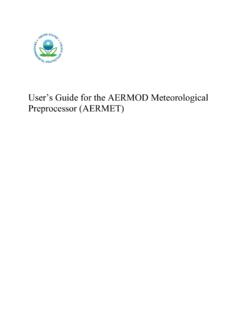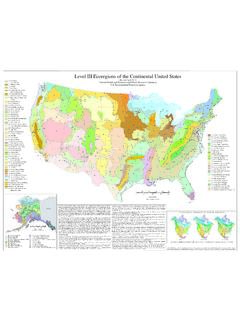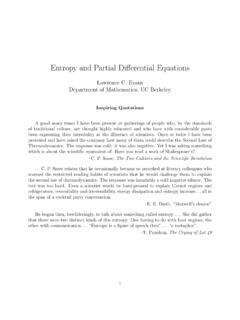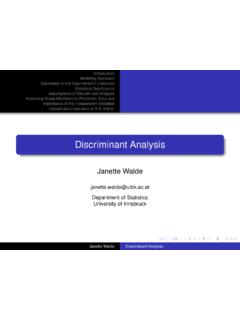Transcription of AERMOD Implementation Guide
1 AERMOD Implementation Guide EPA-454/B-21-006 July 2021 AERMOD Implementation Guide Environmental Protection Agency Office of Air Quality Planning and Standards Air Quality Assessment Division Research Triangle Park, North Carolina ii Preface This document provides information on the recommended use of AERMOD to address specific issues and concerns related to the Implementation of AERMOD for regulatory applications. The following recommendations augment the use of experience and judgment in the proper application of dispersion models. Advanced coordination with reviewing authorities, including the development of modeling protocols, is recommended for regulatory applications of Acknowledgments The AERMOD Implementation Guide has been developed through the collaborative efforts of EPA OAQPS, EPA Regional Office, State, and local agency dispersion modelers, through the activities of the AERMOD Implementation Workgroup.
2 The efforts of all contributors are gratefully acknowledged. iv Contents Section Page What s new in this document? .. 1 Document background and 1 Background (10/19/2007) .. 1 Purpose (10/19/2007) .. 2 Meteorological data and 3 Determining surface characteristics (01/09/2008) .. 3 Meteorological data representativeness considerations (01/09/2008) .. 3 Methods for determining surface characteristics (4/22/2021) .. 4 Use of AERSURFACE for determining surface characteristics (4/22/2021) .. 8 Selecting upper air sounding levels (10/19/2007) .. 9 Processing site-specific meteorological data for urban applications (04/22/2021) .. 10 Use of prognostic meteorological model data as inputs to AERMOD (04/17/2018) .. 10 Terrain data and processing .. 12 modeling sources with terrain-following plumes in sloping terrain (01/09/2008) .. 12 AERMAP DEM array and domain boundary (09/27/2005).
3 13 Terrain elevation data sources for AERMAP (04/22/2021) .. 13 Manually entering terrain elevations in AERMAP (03/19/2009) .. 17 Use of AERMAP to determine source elevations (03/19/2009) .. 17 Urban applications .. 19 Urban/rural determination (08/03/2015) .. 19 Selecting population data for AERMOD s urban mode (10/19/2007) .. 20 Optional urban roughness length URBANOPT keyword (10/19/2007) .. 21 Meteorological data selections for urban applications (01/09/2008) .. 22 Urban applications using NWS meteorological data (01/09/2008) .. 22 Urban applications using site-specific meteorological data (01/09/2008) .. 22 Source characterization .. 23 Capped and horizontal stacks (12/20/2016) .. 23 Use of area source algorithm in AERMOD (09/27/2005) .. 23 Interim Guidance on Model Application .. 25 Guidance on NO2 Background Concentrations with PVMRM (7/26/2021) .. 25 Guidance on BUOYLINE Source Types (7/26/2021).
4 25 REFERENCES .. 27 Appendix A. EPA Model Clearinghouse memorandum dated July 9, 1993 .. 30 AERMOD Implementation Guide July 2021 1 What s new in this document? Revisions dated April 22, 2021: Section , Methods for determining surface characteristics updated for AERSURFACE version 20060 Section , Use of AERSURFACE for determining surface characteristics - updated for AERSURFACE version 20060 Section , Processing site-specific meteorological data for urban applications updated for addition of turbulence options AERMOD version 21112 Section , Terrain elevation data sources for AERMAP Section , Guidance on current Implementation of BUOYLINE deleted due to coding bug fix implemented in AERMOD version 21112 Section , Guidance on using site-specific data with AERMET deleted due to coding bug fix implemented in AERMET version 21112 Revisions dated July 26, 2021: Section Guidance on NO2 Background Concentrations with PVMRM added Section Guidance on BUOYLINE Source Types - added Document background and purpose Background (10/19/2007) In April 2005, the AERMOD Implementation Workgroup (AIWG) was formed in anticipation of AERMOD s promulgation as a replacement for the Industrial Source Complex (ISCST3) model.
5 AERMOD fully replaced ISCST3 as the regulatory model on December 9, 2006 (EPA, 2005a), after a one-year grandfather period. The primary purpose for forming the AIWG was to develop a comprehensive approach for dealing with Implementation issues for which guidance is needed. A result of this initial AIWG was the publication of the first version of the AERMOD Implementation Guide on September 27, 2005. In 2007, a new AIWG was formed as a standing workgroup to provide support to EPA s AERMOD Implementation Guide July 2021 2 Office of Air Quality Planning and Standards (OAQPS). This document represents the combined efforts of AIWG and OAQPS in relation to the Implementation of the AERMOD regulatory model. Purpose (10/19/2007) This document provides information on the recommended use of AERMOD to address a range of issues and types of applications. Topics are organized based on Implementation issues, with additional information as appropriate on whether they impact the modules of the AERMOD modeling system ( AERMOD , AERMET, and AERMAP) or related programs (AERSURFACE, AERSCREEN, and BPIPPRM).
6 The document contains a section which highlights changes from the previous version, located in Section of the document for use as a quick reference. Each section is also identified with the date (mm/dd/yyyy) that it was added or last updated. Only sections with substantive changes or new recommendations are identified with new revision dates. Revision dates are not updated for sections with only minor edits to clarify the wording, correct typographical errors, or update citations to reference the most recent version of a document. The recommendations contained within this document represent the current best use practices as determined by EPA, through the Implementation of AIWG. The document is not intended as a replacement of, or even a supplement to the Guideline on Air Quality Models (EPA, 2017). Rather, it is designed to provide consistent, technically sound recommendations to address specific issues and concerns relevant to the regulatory application of AERMOD .
7 As always, advance coordination with the reviewing authorities on the application of AERMOD is advisable. modeling protocols should be developed, and agreed upon by all parties, in advance of any modeling activity. AERMOD Implementation Guide July 2021 3 Meteorological data and processing Determining surface characteristics (01/09/2008) When applying the AERMET meteorological processor (EPA, 2021a) to prepare the meteorological data for the AERMOD model (EPA, 2021b), the user must determine appropriate values for three surface characteristics: surface roughness length {zo}, albedo {r}, and Bowen ratio {Bo}. The surface roughness length is related to the height of obstacles to the wind flow and is, in principle, the height at which the mean horizontal wind speed is zero based on a logarithmic profile. The surface roughness length influences the surface shear stress and is an important factor in determining the magnitude of mechanical turbulence and the stability of the boundary layer.
8 The albedo is the fraction of total incident solar radiation reflected by the surface back to space without absorption. The daytime Bowen ratio, an indicator of surface moisture, is the ratio of sensible heat flux to latent heat flux and is used for determining planetary boundary layer parameters for convective conditions driven by the surface sensible heat flux. This section provides recommendations regarding several issues associated with determining appropriate surface characteristics for AERMOD modeling applications. Meteorological data representativeness considerations (01/09/2008) When using National Weather Service (NWS) data for AERMOD , data representativeness can be thought of in terms of constructing realistic planetary boundary layer (PBL) similarity profiles and adequately characterizing the dispersive capacity of the atmosphere. As such, the determination of representativeness should include a comparison of the surface characteristics ( , zo, Bo and r) between the NWS measurement site and the source location, coupled with a determination of the importance of those differences relative to predicted concentrations.
9 Site-specific meteorological data are assumed by definition to be representative of the application site; however, the determination of representativeness of site-specific data for AERMOD applications should also include an assessment of surface characteristics of the measurement and source locations and cannot be based solely on proximity. The recommendations presented in this section for determining surface characteristics for AERMET apply to both site-specific and non-site-specific ( , NWS) meteorological data. The degree to which predicted pollutant concentrations are influenced by surface AERMOD Implementation Guide July 2021 4 parameter differences between the application site and the meteorological measurement site depends on the nature of the application ( , release height, plume buoyancy, terrain influences, downwash considerations, design metric, etc.). For example, a difference in zo for one application may translate into an unacceptable difference in the design concentration, while for another application the same difference in zo may lead to an insignificant difference in design concentration.
10 If the reviewing agency is uncertain as to the representativeness of a meteorological measurement site, a site-specific sensitivity analysis may be needed in order to quantify, in terms of expected changes in the design concentration, the significance of the differences in each of the surface characteristics. If the proposed meteorological measurement site s surface characteristics are determined to NOT be representative of the application site, it may be possible that another nearby meteorological measurement site may be representative of both meteorological parameters and surface characteristics. Failing that, it is likely that site-specific meteorological data will be required. Methods for determining surface characteristics (4/22/2021) The availability of high-resolution digitized land cover databases provides an opportunity to apply systematic procedures to determine surface characteristics based on an objective analysis of the gridded land cover data across a domain.









